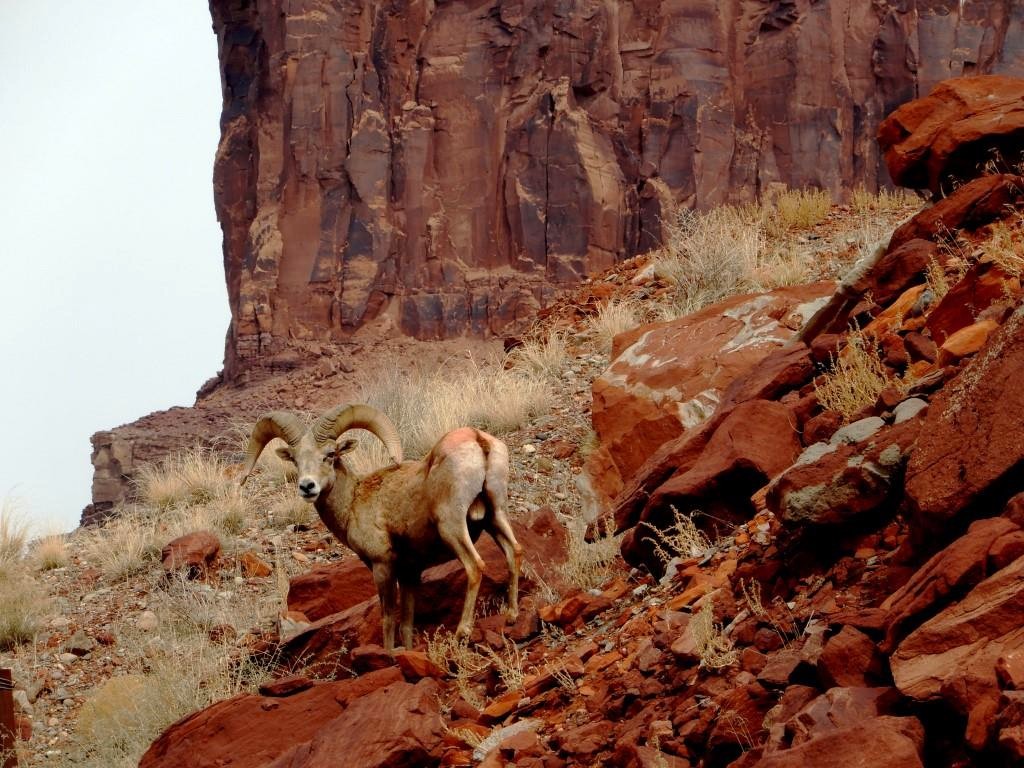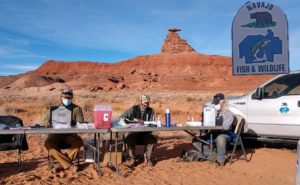
Today, bighorns everywhere are at a mere 5% of their historical abundance. Modern practices have contributed to the loss of the species. Photo: Joel Berger/CSU
Some of the world’s most sacred and spectacular lands unfold across the sovereign Navajo Nation – an area nearly the size of Maine encompassing parts of Arizona, Utah and New Mexico. Here, desert bighorn sheep slip silently from view in rugged canyons and among red sandstone cliffs. Evocative petroglyphs and pictographs of the animal, which has been hunted and revered across time, adorn rocks throughout the area.
It is also here that a team of Navajo tribal authorities with veterinarians and scientists from Denver Zoo, Colorado State University and the Wildlife Conservation Society successfully captured and released 90 bighorn sheep in December 2020.
The team aims to diagnose respiratory disease in the bighorns and track the movement of rams and ewes as the first phase of a study led by Denver Zoo. CSU Professor Joel Berger, who is part of the project, explained that the disease contributes heavily to juvenile and adult mortality.
Berger said people involved in the project are cooperating for a common good and for a species of great local relevance to the Navajo people.
“That is something to be celebrated,” he said.
Loss of iconic bighorn sheep affects ecosystems

Today, bighorns everywhere are at a mere 5% of their historical abundance. Modern practices – roads, disease, overharvest and competition with livestock – have contributed to the loss of the species. By the 1990s, only 34 individual desert bighorn sheep remained on the Navajo Nation, living along the San Juan River.
Tribal authorities have been working to reverse these trends and are involved in restoration and conservation efforts in Arizona and Utah.
To prioritize the species’ recovery, Navajo Nation Fish and Wildlife, with the help of Stevens Wildlife Consulting, established the Navajo Bighorn Sheep Recovery Program in 1997. Since that time, the teams successfully established two additional populations of bighorn sheep on Navajo lands.
Populations steadily increased and peaked at 600 animals in 2016, but a pneumonia epidemic now threatens that recovery and has sent two of three populations into precipitous decline.
Jessica Fort, wildlife biologist for the Navajo Nation and the architect of a recent ongoing conservation effort, said she is confident that the project will be successful.
“We hope that the bighorn sheep can continue to play an important role, ecologically, economically and culturally, in the Nation’s future,” she said.
Currently, tissue samples from the bighorns are being analyzed for Mycoplasma ovipneumoniae, a respiratory pathogen known to affect wild sheep and goats. The wide-ranging movements of bighorn rams are also being monitored to chart visits to domestic herds of sheep.
Supported by $260,000 in grants from the Bureau of Indian Affairs and U.S. Fish and Wildlife Service, the project covers the remote northern lands of the reservation, with boundaries that expand southward from the San Juan River and from Glen Canyon units managed by the U.S. National Park Service.
Collaborations add value to conservation efforts
Jeff Cole, wildlife manager of the Navajo Fish and Wildlife Department said there is real value added to the project, thanks to cooperation among tribal authorities with state and federal agencies, coupled with university and non-governmental organizations.
“If we really want our bighorn sheep populations to thrive, we need a broader knowledge base and a way to ensure that people are involved in building solutions while also incorporating the latest science,” he said.
Berger, the Barbara Cox-Anthony Chair of Wildlife Conservation at CSU and senior scientist at Wildlife Conservation Society, said the success of the collaboration revealed itself in numerous ways.
“When the centrifuge we used to process the bighorn samples in the field failed, we had offers from Navajo communities some 150 miles away to help, as well as from the Bureau of Land Management, from private veterinary clinics and from local hospitals,” he said.
The second phase of this research project will include a collaboration with local domestic sheep herders to identify possible respiratory disease reservoirs, and ultimately suggest solutions to prevent the spread of disease.
About the Navajo Nation Department of Fish and Wildlife
The Navajo Nation is a federally recognized Indian tribe with 18 million acres of land in Arizona, New Mexico and Utah. The mission of its Department of Fish and Wildlife is to “conserve, protect, enhance, and restore the Navajo Nation’s fish, wildlife, and plants through aggressive management programs for the spiritual, cultural, and material benefit of present and future generations of the Navajo Nation.”